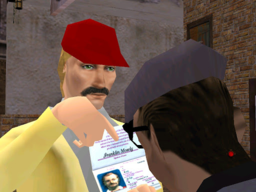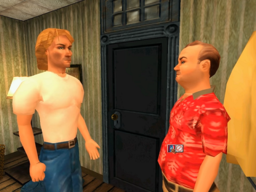Cat hair mustache puzzle
The cat hair mustache puzzle is a puzzle in the video game Gabriel Knight 3: Blood of the Sacred, Blood of the Damned. The puzzle's name is owed to the use of cat hair as a fake mustache, which protagonist Gabriel Knight uses as part of a disguise in order to steal a man's motorcycle rental. The puzzle was created by the game's producer, Steven Hill, following a puzzle being worked on by the game's creator, Jane Jensen, having to be cut due to budgetary reasons. The designers disliked the puzzle, but because of time constraints, it had to be left in.

The puzzle has received generally negative reception, identified as one of the causes of adventure games becoming less popular due to it being too obtuse and frustrating. Game designer Erik Wolpaw was highly critical of it, blaming Jane Jensen for it despite her non-involvement. Wolpaw's article caused Jensen to face harassment from people who thought her a poor game designer for it, a portion whom Jensen noted had not played the game.
Puzzle and solution
In Gabriel Knight 3: Blood of the Sacred, Blood of the Damned, players control protagonist Gabriel Knight. At one point during the game, Gabriel is tasked with impersonating another man in order to take his motorcycle rental. In order to do this, Gabriel must collect a variety of items. Grabiel creates a mustache using masking tape, which he puts a piece of on a shed door. Gabriel uses a hose to spray a cat which is on top of a fence, causing the cat to run through the shed door. This causes part of the cat's fur to be torn off, which he takes. Gabriel then must distract the man by getting him to come downstairs and use a piece of candy to distract him, causing the man to bend over while outside of his room and allowing Gabriel to steal his passport. Gabriel then heads to the man's room in order to steal his gold coat and don it, along with a red cap he finds in the lost and found to hide that he had hair, unlike the man. Gabriel then use a packet of maple syrup to adhere the fur to his face, creating a false mustache. Using a magic marker, Gabriel then adds a fake mustache to the passport in order to obscure the differences between their faces. He then returns, disguise complete, and successfully takes the man's motorcycle rental.
Concept and creation
The puzzle was created by Gabriel Knight 3 producer Steven Hill, as a result of a puzzle created by the game's creator, Jane Jensen, needing to be removed due to budget concerns.[1][2][3] The cat hair mustache puzzle was unpopular with the game's lead technical designer, Scott Bilas, as well as other members of the development team, but was included due to time constraints.[2] Jensen attributed the difficulty of the cat hair mustache puzzle to both the length of the puzzle and the lack of hints, though felt it was overblown, even though she didn't like it herself.[3]
Reception and legacy

The cat hair mustache puzzle has received generally negative reception from critics, coming to be known as shorthand for "obscure and illogical actions" players may need to take in adventure games.[2] PC World writer Hayden Dingman called it an "infamous" puzzle and emblematic of how difficult Sierra games can be.[4] Kotaku writer Kirk Hamilton identified it as a "terrible-adventure-game-puzzle icon" and that no one would be able to solve it without a strategy guide.[3] In their review of Gabriel Knight 3, Computer Gaming World writer Tom Chick identified it as the most notable aspect of the game, despite finding puzzles later in the game being more difficult. They explain that the earlier appearance of the puzzle caused a greater impact on the experience as a result.[5] Gamasutra writer Christian Nutt felt that the puzzle was obtuse, stating that it was not something a player would think to do.[6] Hardcore Gaming 101 writer Kurt Kalata called it the game's most "infamous" puzzle; he felt that such an "odd" puzzle would be appropriate for a more cartoony game like Maniac Mansion: Day of the Tentacle, but that the Gabriel Knight series is more firmly grounded in realism, making the puzzle seem "absurd."[7] A puzzle in the video game Broken Sword 5: The Serpent's Curse requires players to make a goatee and mustache using adhesive strips and stuffed dog fur, spurring IGN writer Chuck Osborn to speculate whether it was a reference to the cat hair mustache puzzle.[8]
Jane Jensen took some blame for the death of adventure games due to Gabriel Knight 3, with game designer Erik Wolpaw placing blame on her for the puzzle's poor design.[2] Wolpaw was critical of the puzzle for requiring people to make a fake mustache in order to impersonate someone without a mustache, and that the actual process of constructing the mustache went beyond sense.[9] Jensen faced backlash for this puzzle despite not being responsible for it; she received harassment from people who read Wolpaw's speech, calling it "typical Internet hate," and discussed how these people viewed her as "the worst game designer in the world" as a result of it.[1] GamesRadar+ writer Charlie Barratt included it in their list of the "stupidest puzzles" in video games, suggesting that the puzzle was "illogical and irrational" and that the puzzle contributed to adventure games dying out.[10] Despite the blame laid on the puzzle for killing adventure games, author Grant Bollmer disputed this notion, instead placing blame on corporate restructuring, "meddling in the creative process," and an "increasing scale" in video games' popularity.[11]
Campo Santo designer and programmer Nels Anderson felt that adventure games from the '90s were good in spite of their gameplay, claiming that no one plays them for their "obtuse puzzles," citing the cat mustache puzzle specifically.[12] Anderson was critical of the puzzle particularly due to the game expecting players to don a fake mustache to impersonate someone who does not have one.[13] Frictional Games co-founder Thomas Grip identified the puzzle as a "shining example" of what gameplay designers should not do.[14]
References
- Craddock, David L. (November 20, 2015). "Hunting Shadows: The Making of Gabriel Knight – Chapter 5". Episodic Content. Archived from the original on May 13, 2020. Retrieved July 5, 2020.
- Salter, Anastasia (2017). Jane Jensen: Gabriel Knight, Adventure Games, Hidden Objects - Influential Video Game Designers. Bloomsbury Publishing USA. ISBN 1501327453. Retrieved July 5, 2020.
- Hamilton, Kirk (April 21, 2012). "How We Survived Adventure Gaming's Most Hair-Tearingly Ridiculous Puzzles". Kotaku. Archived from the original on June 19, 2020. Retrieved July 5, 2020.
- Dingman, Hayden (October 21, 2014). "Gabriel Knight: Sins of the Fathers 20th Anniversary review: Haunted by the past". PC World. Archived from the original on November 5, 2016. Retrieved July 5, 2020.
- Chick, Tom (April 2000). "Third Time's a Curse". Computer Gaming World. No. 189. pp. 74, 75.
- Nutt, Christian (September 9, 2011). "SpyParty And The Indie Ethos: Chris Hecker Speaks". Gamasutra. p. 3. Archived from the original on June 18, 2020. Retrieved July 5, 2020.
- Kalata, Kurt (November 22, 2010). "Gabriel Knight 3: Blood of the Sacred, Blood of the Damned". Hardcore Gaming 101. Archived from the original on December 5, 2019. Retrieved July 5, 2020.
- Osborn, Chuck (December 24, 2013). "Broken Sword 5: The Serpent's Curse Review in Progress". IGN. Archived from the original on November 20, 2018. Retrieved July 5, 2020.
- Wolpaw, Erik (September 11, 2000). "Death of Adventure Games". Old Man Murray. Retrieved July 7, 2020.
- Barratt, Charlie (September 29, 2008). "The Top 7... Stupidest Puzzles". GamesRadar+. p. 4. Archived from the original on June 3, 2020. Retrieved July 5, 2020.
- Bollmer, Grant (April 18, 2019). "The Kinesthetic Index: Video Games and the Body of Motion Capture". InVisible Culture. Archived from the original on June 22, 2020. Retrieved July 5, 2020.
- Ore, Jonathan (February 13, 2016). "Explore Wyoming forest and uncover a mystery in Firewatch". Canadian Broadcasting Company. Archived from the original on December 7, 2019. Retrieved July 5, 2020.
- Anderson, Nels (May 5, 2009). "Without Readability - The Decline of Adventure Games". Gamasutra. Archived from the original on June 20, 2020. Retrieved July 5, 2020.
- Grip, Thomas (April 29, 2014). "4-Layers, A Narrative Design Approach". Gamasutra. Archived from the original on June 19, 2020. Retrieved July 5, 2020.